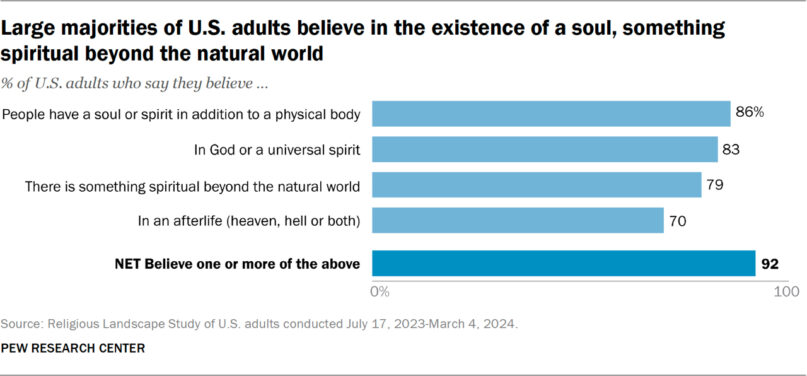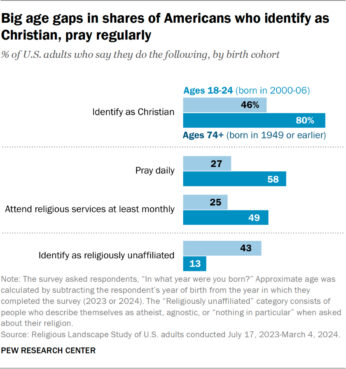Additionally, the growth of the religiously unaffiliated, also called nones, has plateaued after decades of rapid growth. In 2007, they represented 16% of U.S. adults, rising to 23% in 2014, and 29% in 2023-24. It includes 5% who identify as atheists, 6% who describe themselves as agnostics and 19% who identify as “nothing in particular.”

“Large majorities of U.S. adults believe in the existence of a soul, something spiritual beyond the natural world” (Graphic courtesy of Pew Research Center)
More than 8 out of 10 American adults indicated they were spiritual or believe in the supernatural; 86% agreed people have a soul or spirit in addition to their physical body. A large portion also believe in God or a universal spirit (83%) and/or something spiritual beyond the natural world (79%). About 70% indicated they believe in heaven, hell or both. These figures are relatively the same across age categories.
Though this latest study shows a stabilizing religious composition in America, Pew researchers project a decline in religiousness in the future. Less religious younger generations are progressively expected to replace older, highly religious and heavily Christian generations.
“This means that, for lasting stability to take hold in the U.S. religious landscape, something would need to change,” the report explains. “For example, today’s young adults would have to become more religious as they age, or new generations of adults who are more religious than their parents would have to emerge.”
While 54% of adults ages 54 and older said they pray daily, only 31% ages 24-34 do so, and 27% for ages 18-24. Younger cohorts also attend religious services less often compared with older generations and are also less likely to express beliefs in God or the universal spirit than other generations.

“Big age gaps in shares of Americans who identify as Christian, pray regularly” (Graphic courtesy of Pew Research Center)
The trend could shift if younger Americans became more religious as they age, which is unlikely to happen as such a trend has never been observed before, the report notes. And comparing the results to previous report findings, between 2007 and 2023-24, each age group has become less religious as it aged.
The share of American adults who switched religions since childhood, at 35%, has also increased the religiously unaffiliated and led to fewer people identifying as Christians.
The percentage of Americans who engage in religious practices remained relatively stable over the last few years, despite decreasing from 2007, according to Pew. In the 2023-24 report, 44% of respondents said they pray at least once a day, which is consistent with 2021 findings from Pew’s annual National Public Opinion Reference Survey. However, that’s down from 55% who said they prayed daily in 2014, and 58% in 2007.
Also, in Pew’s 2020 NPORS, 33% of U.S. adults said they attend religious services at least once or twice a month. Similar results were found in 2023-24 data, indicating stability over the last several years.
Besides the generational aspect, other factors such as gender and political affiliations seem to weigh in levels of religiousness. Overall, women are more religious than men, but that figure appears to be narrowing slightly. Women are more likely to pray daily (50% to 37% for men) and are more likely to believe in God or a universal spirit (59% to 49%).
Liberals also seem to be less likely to identify as Christians, with a notable decrease since 2007 — today, 37% of self-described political liberals identify as Christian, compared with 62% who did in 2007. Among self-described conservatives, 89% identify as Christian today, compared with 82% in 2007.
This article originally appeared here.

